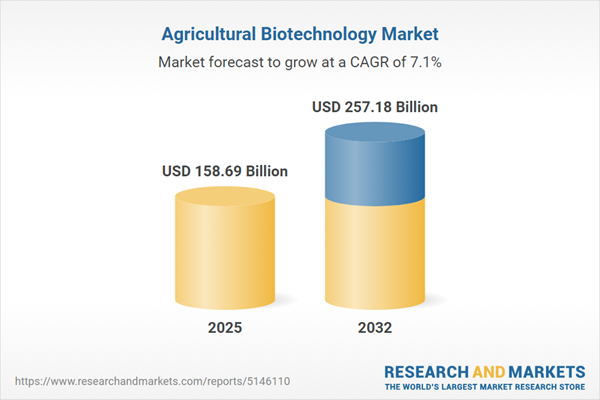Speak directly to the analyst to clarify any post sales queries you may have.
The agricultural biotechnology market is experiencing robust expansion driven by technological advancements and a growing focus on global food security. Senior leaders prioritize data-backed insights and strategic perspectives in responding to evolving market, regulatory, and competitive dynamics.
Market Snapshot: Agricultural Biotechnology Market Size and Growth Outlook
The agricultural biotechnology market grew from USD 148.81 billion in 2024 to USD 158.69 billion in 2025 and is projected to reach USD 257.18 billion by 2032, advancing at a CAGR of 7.07%. This upward trajectory reflects continued investment in genetic engineering, molecular diagnostics, and bioinformatics as agribusinesses address demands for resilient crops, sustainability, and supply chain adaptability, with cross-sector partnerships accelerating innovation across global regions.
Scope & Segmentation
This report offers a comprehensive segmentation across technologies, applications, products, crop types, end users, and regions, equipping decision-makers with actionable frameworks for strategic planning.
- Technology: Bioinformatics, Genetic Engineering (including CRISPR/Cas9, gene editing, transgenic methods), Genomics and Molecular Markers (DNA sequencing, marker-assisted selection), Microbial Biotechnology, Molecular Diagnostics, Synthetic Biology, Tissue Culture.
- Product Type: Animal biotechnology products, biofertilizers, biopesticides, genetically modified crops and transgenic seeds, plant growth regulators.
- Crop Type: Cereals (barley, maize, rice, wheat), fruits and vegetables, oilseeds (rapeseed, soybean, sunflower), pulses (chickpea, lentil, pea).
- Application: Crop improvement (abiotic stress tolerance, pest resistance, yield enhancement), disease management, environmental sustainability, livestock health and productivity, soil fertility management.
- End User: Agricultural cooperatives, biotech companies, farmers and growers, government and regulatory agencies, research institutions, seed manufacturers.
- Region: Americas (United States, Canada, Mexico, Brazil, Argentina, Chile, Colombia, Peru), Europe, Middle East & Africa (United Kingdom, Germany, France, Russia, Italy, Spain, Netherlands, Sweden, Poland, Switzerland, UAE, Saudi Arabia, Qatar, Turkey, Israel, South Africa, Nigeria, Egypt, Kenya), Asia-Pacific (China, India, Japan, Australia, South Korea, Indonesia, Thailand, Malaysia, Singapore, Taiwan).
- Company Coverage: Includes ADAMA Ltd, Agrinos AS, Andermatt Biocontrol AG, Arcadia Biosciences, BASF SE, Bayer CropScience, Bioworks, Certis USA, CIBO Technologies, Corteva, Evogene, FMC Corporation, Indigo Ag, Koppert Biological Systems, KWS SAAT, Limagrain, Marrone Bio Innovations, Nufarm, Performance Plants, Pivot Bio, Symbiomics, Syngenta, UPL Limited, Valent BioSciences, and others.
Key Takeaways for Senior Decision-Makers
- The agricultural biotechnology market is shaped by rapid innovation, with gene editing, synthetic biology, and bioinformatics unlocking new avenues for crop resilience and productivity.
- Strategic alliances between large firms and emerging startups enable cross-disciplinary innovation, supporting the co-development of data-driven and sustainable solutions.
- Digital agriculture integration is enabling precision interventions, improving farm management and resource efficiency across diverse crop cycles.
- Regulatory adaptation and engagement have become critical, with evolving compliance requirements impacting product commercialization and investment flows.
- Consumer demand for traceability and sustainable practices is prompting rapid adoption of molecular diagnostics and blockchain-enabled tracking in agricultural supply chains.
- Regional policy frameworks and investment priorities drive notable differences in technology adoption, commercialization timelines, and partnership models across global markets.
Tariff Impact and Supply Chain Adaptation
Recent changes to United States tariff schedules have introduced supply chain complexities, particularly affecting sourcing strategies for proprietary enzymes, sequencing reagents, and biocontrol agents. Producers are diversifying suppliers, adopting dual sourcing, and engaging regulators to advocate for tariff relief on essential biotech inputs. These risk management efforts help maintain R&D continuity and minimize supply chain disruptions.
Methodology & Data Sources
Research findings are grounded in a mixed-methods framework, integrating structured interviews with biotechnology executives, regulatory experts, and stakeholders, alongside a thorough review of peer-reviewed journals, patent filings, company reports, and policy documents. Quantitative data undergoes rigorous validation, scenario analysis, and triangulation to ensure actionable, reliable insights for strategic decision making.
Why This Report Matters for Strategic B2B Decisions
- Delivers actionable segmentation across technologies, applications, and regions to inform targeted investments and competitive positioning in agricultural biotechnology.
- Provides clarity on the interplay between regulatory changes, market drivers, and supply chain dynamics, enabling organizations to confidently anticipate risks and capitalize on new opportunities.
- Empowers senior decision-makers with concise, data-based recommendations for leveraging partnerships, advancing digital integration, and enhancing compliance strategies in a dynamic global market.
Conclusion
The agricultural biotechnology market offers significant potential for sustainable growth and innovation. Strategic adaptation to technological, regulatory, and supply chain trends is essential for long-term success. This report equips industry leaders to confidently shape the future of agricultural science and productivity.
Additional Product Information:
- Purchase of this report includes 1 year online access with quarterly updates.
- This report can be updated on request. Please contact our Customer Experience team using the Ask a Question widget on our website.
Table of Contents
3. Executive Summary
4. Market Overview
7. Cumulative Impact of Artificial Intelligence 2025
Companies Mentioned
The companies profiled in this Agricultural Biotechnology market report include:- ADAMA Ltd
- Agrinos AS
- Andermatt Biocontrol AG
- Arcadia Biosciences, Inc.
- BASF SE
- Bayer CropScience AG
- Bioworks, Inc.
- Certis USA LLC
- CIBO Technologies, Inc.
- Corteva, Inc.
- Evogene Ltd.
- FMC Corporation
- Indigo Ag, Inc.
- Koppert Biological Systems NV
- KWS SAAT SE & Co. KGaA
- Limagrain
- Marrone Bio Innovations, Inc.
- Nufarm Limited
- Performance Plants Inc.
- Pivot Bio, Inc.
- Symbiomics S.A.
- Syngenta AG
- UPL Limited
- Valent BioSciences LLC
Table Information
| Report Attribute | Details |
|---|---|
| No. of Pages | 188 |
| Published | November 2025 |
| Forecast Period | 2025 - 2032 |
| Estimated Market Value ( USD | $ 158.69 Billion |
| Forecasted Market Value ( USD | $ 257.18 Billion |
| Compound Annual Growth Rate | 7.0% |
| Regions Covered | Global |
| No. of Companies Mentioned | 25 |









